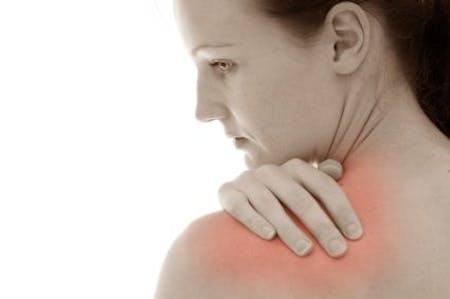
The shoulder is a large and complex synovial, ball and socket joint located between the head of the humerus (upper arm one) and the glenoid cavity (articular surface) of the scapula.
The shoulder complex is made up of three bones:
- Humerus – held in place within the glenoid cavity by the long head of the bicep tendon and reinforced by the rotator cuff.
- Scapula (shoulder blade) – the shoulder (pectoral) girdle bone that has a prominent ridge and two concave areas (supraspinous and infraspinous fossae). The top outer edge of the scapula is called the acromion. It is a sideway extension of the backbone on the shoulder plate that forms the acromioclavicular joint together with the clavicle.
- Clavicle (collarbone) – a curved, horizontal, s-curved, rod-shaped bone located at the base of the neck in the front (anterior) part of the body.
…and four joints:
- Glenohumeral (GH) – a true synovial ball-and-socket style diarthrodial (freely moving) joint that connects the upper extremity to the trunk.
- Acromioclavicular (AC) – a gliding (plane style) synovial joint that connects the sternum with the clavicle.
- Sternoclavicular (SC) – a saddle type synovial joint (sometimes known as a double-plane joint) located where the clavicle (collarbone) meets the sternum (breastbone) at the base of the neck.
- Scapulothoracicic (ST) – not a true anatomical joint but rather a “floating joint” that is an articulation (joint or juncture between bones or cartilages) of the scapula with the thorax.
The glenohumeral joint is the main shoulder joint. It is the most mobile of any joint in the body and the most unstable. It is the most commonly dislocated joint in the shoulder. Watch the video below to learn more.
How We Can Help
Physical therapists (PTs) are experts in the art and science of the evaluation and treatment of shoulder movement dysfunctions. We care for people of all ages and treat a variety of muscle, joint and neurological conditions.
Conditions we have successfully treated:
- Impingement*
- Rotator Cuff Tear
- Instability
- Fracture/Trauma
- Frozen Shoulder
- Tendinopathy
- Arthritis
What are my treatment options?
- Drugs
- Surgery
- Physical Therapy*
Advantages of Physical Therapy:
- No side effects.
- Cost-effective.
- Supported by clinical research*.
- Customized to treat the underlying cause.
Your Recovery Process:
- Pain Relief
- Restoration of Normal Movement
- Recovery of Function
- Independent Care.
Components of Your Care:
- A thorough biomechanical evaluation.
- Customized treatment plan.
- Extensive patient education.
- Hands-on techniques to relax the muscles and recover mobility.
- Stretching for tight muscles.
- Strengthening of weak muscles.
- Mobilization of stiff joints.
- Modalities such as ice, heat, ultrasound or electrical stimulation.
Everyone is different. You may require one or two visits, or an extended care plan over several weeks or months. If you’re ready for relief, and tired of “masking” your pain, treat the cause, not just the symptoms!
* Physical therapy has been proven to be as effective as surgery. Ann Rheum Dis. 2005 May:64(5).
